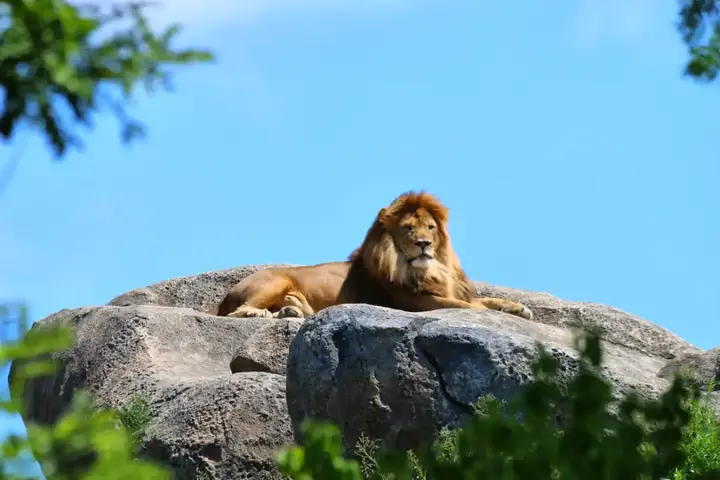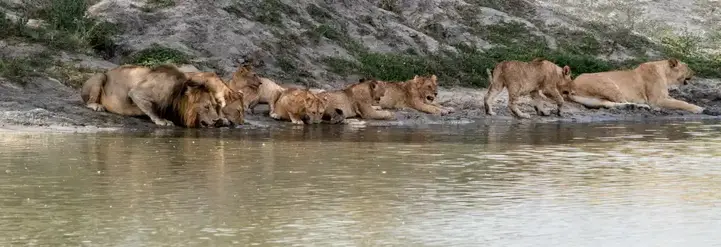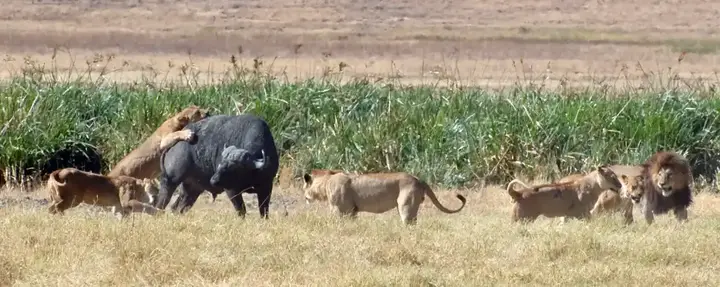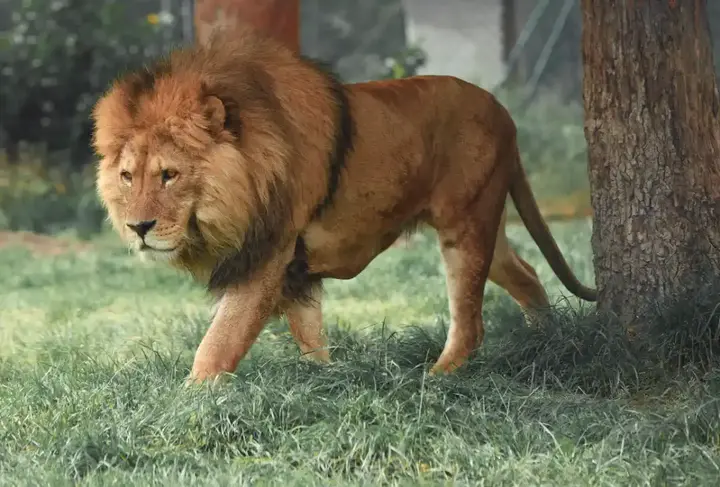Is the lion the king of the African savannah?

In the animal kingdom, few creatures are respected, admired, and awe as a lion. Thanks to his royal presence, impressive mane, and majestic stature, the lion has long been revered as the king of beasts. From ancient civilizations to modern cultures, the lion has been a symbol of strength, courage and majesty. This article examines the qualities of a lion, and why he has the reputation of the king of the African savannah.
Show key points
- Lions are revered across cultures for their majestic presence, strength, and symbolic association with royalty and courage, earning them the title "King of the Savannah."
- As apex predators, lions sit at the top of the food chain with no natural enemies, playing a critical role in maintaining the balance of their ecosystem by regulating herbivore populations.
- Their physical adaptations—such as a powerful build, night vision, camouflage fur, and thermoregulation—enable them to thrive in the challenging savannah environment.
- ADVERTISEMENT
- Lions exhibit complex social behaviors, living in structured prides with cooperative hunting tactics, territorial defense, and strong intra-group bonds.
- In many world cultures, lions symbolize power, protection, and nobility, often appearing in folklore, religion, art, and national emblems from Africa to Asia and Europe.
- Threats such as habitat loss, human-wildlife conflict, poaching, disease outbreaks, and climate change endanger lion populations across their natural range.
- Conservation efforts are vital to ensure the lion's survival, requiring coordinated strategies including habitat protection, conflict mitigation, and sustainable land-use practices.
Its physical qualities:

The lion, with its Latin name (Panthera leo), is the second largest species of big cat in the world, after the tiger, and is characterized by a muscular structure and a distinctive golden coat. One of his most prominent features is his magnificent mane that adorns the male neck, a symbol of strength and masculinity. While females lack this crown, they have a slim and powerful figure that is unmatched, and females contribute as well as males to the survival of the species.
Recommend
What makes a lion the king of the savannah?

The lion earned the nickname "King of the Savannah" due to a combination of factors related to his behavior, physical qualities, and environmental role within his environment. Here are several reasons behind this name:
Dominance in the food chain: Lions are at the top of the food chain in their ecosystems. Lions have no natural predators and play a crucial role in regulating the populations of herbivores such as zebras, wild animals, and buffaloes.
Social structure: Lions exhibit a complex group-centered social structure, usually led by a dominant male lion. This social organization allows lions to effectively coordinate hunting efforts and defend their territory against rival groups. Individuals form strong bonds through play, shared activities and mutual cleaning, fostering a sense of cohesion and cooperation.
Strength: Male lions are among the largest carnivores in Africa, characterized by impressive muscular structure and a strong jaw capable of eliminating much larger prey. In addition, the distinctive male lion mane serves as a visual symbol of power and dominance.
Royal behavior: Lions carry a pronounced royal aura, exuding confidence and authority as they roam the savannah. Her majestic appearance, combined with her courage and dominant presence, earned her the reputation of royalty in the animal kingdom.
Cultural and symbolic significance: Throughout human history, lions have been revered as symbols of strength, courage and nobility in various cultures and myths. Its association with kings and leadership reinforces its status as savannah kings.
In fact, Assad is important in different areas. Here we address its biological adaptations, behavioral complexities, cultural symbolism, and the threats it faces.
How does a lion adapt to its environment?

The majestic lion has developed a range of adaptations that allow it to live and thrive in a challenging savannah environment. These adaptations include physical, behavioral and environmental aspects, enabling lions to excel as predators in their environment. Among these adaptations are:
1- Camouflage: The yellowish-brown lion's fur blends well with the golden colors of savannah pastures, providing it with effective camouflage during hunting and ambushes.
2- Muscular construction: Lions have strong muscles and skeletons that enhance their strength and agility. This physical dexterity is necessary for chasing prey, for fighting with large herbivores while hunting, and for defending the territory against rival predators or intrusive lions.
3- Night activity: The lion is a night hunter. It relies on low-light conditions to effectively hide its approach and ambush prey. Accurate night vision and sharp hearing and smell help him detect prey and navigate the savannah under cover of darkness.
4- Water dependence: Unlike some other big cats, lions are not well adapted to survive without regular access to water. Therefore, they usually create areas near permanent water sources such as rivers, streams, or water vents. Dependence on water sources affects their movement patterns and hunting strategies, as lions need to balance the risk of exposure to prey with the need to stay hydrated.
5- Thermoregulation: Lions have developed physiological mechanisms to deal with large temperature differences in the savannah, where temperatures can rise a lot in the day and drop a lot at night. Their large size helps them retain heat during cold periods, while their ability to pant and sweat helps them dissipate excess body heat.
Behavioral complexities:

The lion has a range of behavioral complexities that contribute to his social structure, hunting strategies, and communication within his group. These behaviors have evolved over thousands of years and play a critical role in Assad's survival. Here are some of the main behavioral complexities of the majestic lion:
1- Social structure: Lions are very social animals, living in groups. A typical group usually consists of many related females, their offspring of different ages, and an alliance of one or more dominant males. This social structure serves various purposes, including cooperative hunting, land protection and cub breeding. Within the group, each member plays a vital role, ensuring the group's survival in the harsh African savannah.
2- Cooperative hunting: Lions are famous for their prowess in hunting. One of the most prominent aspects of lions' behavior is their ability to hunt as a group. Working together in coordinated attacks, lionesses use their speed and agility to chase prey using coordinated tactics to increase their chances of success, while males provide the strength needed to shoot down larger animals. This cooperative hunting strategy allows lions to shoot down much larger prey, which can be difficult for a single lion to deal with alone. This cooperative behavior ensures an adequate food supply for the entire group.
3- Possessive behavior: Lions are regional animals that defend exclusive areas within the savannah. These areas provide access to key resources such as water and prey. Male lions, in particular, play a vital role in patrolling and defending group territory against rival groups and intrusive individuals. Roaring, smell, and physical encounters are common tactics used by lions to assert their dominance and deter potential threats on their territory.
4- Reproductive behavior: Lions show different reproductive behavior than females, and often engage in aggressive displays and voices to establish dominance and mating rights within the group. During mating periods, lionesses may exhibit receptive behaviors, attracting the attention of males who dominate mating. Successful mating events lead to the birth of cubs, which are cared for by all members of the group.
5- Communication: Lions use a variety of sounds, body postures, and olfactory signals to communicate with each other within the group, as well as to indicate their presence to competitors. Roaring is perhaps the most famous voice of lions, serving as a means of territorial proclamation, social cohesion, and assertion of dominance. Other sounds include grunts, growls, snarls, and purring, each conveying different messages depending on the context.
6- Social cohesion: Lions engage in different social behaviors that strengthen bonds within the group, and maintain social cohesion. Mutual cleaning and affectionate play are common interactions observed among group members, especially between mothers and their offspring. These social ties help strengthen the unity of the group and promote cooperation during hunting and territorial defense.
Cultural symbolism:

The cultural symbolism of Assad varies across different regions of the world, reflecting the diverse views and beliefs of different cultures and civilizations. Here's a glimpse of how Assad is viewed and respected on the continents of the world:
African: In many African cultures, the lion holds deep significance as a symbol of strength, courage and nobility. Among indigenous tribes, lions are often revered as ancestral spirits, or divine beings embodying traits such as power, leadership, and protection. In addition, lions appear prominently in African folklore and mythology, as they are depicted as mythical creatures with supernatural abilities. Its roar, in particular, is believed to carry spiritual significance, symbolizing divine authority and presence.
Asia: In many Asian cultures, the lion is revered as the guardian and protector, often depicted in religious arts and architecture. In Hinduism and Buddhism, lions are associated with gods such as Shiva and Buddha, and symbolize divine power, wisdom and protection. Lion statues are commonly found to guard temples, palaces and sacred sites throughout Asia, acting as guardians against evil spirits and malicious forces. In Chinese culture, lions are also revered as a symbol of power and prosperity, and are often depicted in traditional art and folklore as auspicious creatures that bring good luck and blessings.
Europe: In European heraldry and medieval iconography, the lion was synonymous with monarchy, sovereignty and chivalry. Lions appeared on the coats of arms, flags and emblems of many European kingdoms and noble families, symbolizing their power and lineage. The lion's association with the monarchy dates back to ancient times, when rulers such as Alexander the Great and Richard the Lionheart adopted the lion animal as a symbol of their power and authority.
America: In the Americas, Assad's cultural symbolism is influenced by European and African traditions, as well as indigenous beliefs and mythology. In North America, Assad's association with strength and courage is reflected in popular culture and symbolism, where he is often used to represent sports teams, military units, and national identities. In South America, where lions are not native to them, their symbolism may be less widespread but they are still influenced by universal perceptions of the animal as a symbol of power and majesty.
What threats does Assad face?

Despite being revered as the king of the savannah, Assad faces countless threats that jeopardize his survival in the wild. These threats stem from human activities, habitat loss, conflicts with humans, and other environmental factors. Here are some of the primary threats that lions face:
1. Habitat loss and fragmentation: Population expansion and agricultural activities have led to widespread habitat loss and fragmentation of lions' lands. With the conversion of natural habitats into agricultural land and urban areas and the development of infrastructure, lions are increasingly confined to smaller, smaller, more isolated enclaves. This division reduces the availability of suitable prey, disrupts migration routes, and limits the flow of genes between lions, increasing their vulnerability to extinction.
2- Conflict between man and wildlife: Lions often clash with humans over resources such as livestock and water. In rural areas bordering lions' habitats, looting of cattle by lions can lead to revenge killings by farmers seeking to protect their livelihoods. Similarly, lions may be targeted by poachers looking for their skins, bones and other parts of them, which are used in traditional medicine and ceremonial rituals and as status symbols.
3- Low prey populations: Depletion of prey populations due to poaching can greatly affect the survival of lions. With prey scarce, lions may resort to targeting local livestock.
4- Climate change: Climate change poses a growing threat to lions; rising temperatures and changing rainfall patterns can disrupt ecosystems, alter vegetation patterns, and reduce water availability, affecting prey abundance and distribution patterns.
5- Outbreaks of diseases: Lions are susceptible to various diseases, including canine fever, tuberculosis, and HIV in cats. Outbreaks can wipe out lions' populations, especially in areas where they are under pressure from other threats. Furthermore, diseases transmitted from domestic animals can pose additional risks to wild lion populations. Addressing these threats requires a concerted effort from governments, conservation organizations and local communities. Conservation strategies aimed at protecting lions' habitats, mitigating human-wildlife conflict, combating poaching and illegal trade, and promoting sustainable land management practices are essential to ensure the long-term survival of the majestic lion in the wild.








